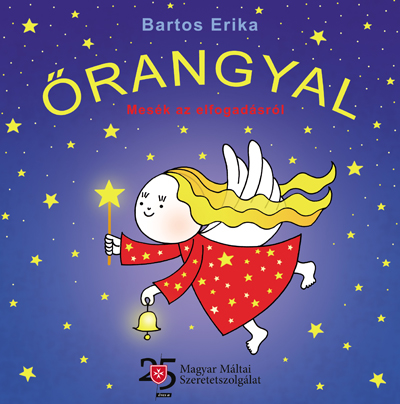 1. After the Anna, Pete and Greg and Berry and Dolly storybook series, poetry books and other children’s books your new storybook entitled Guardian Angel is published soon, which similarly to the book entitled Bravery Test and Heart Brochure helps the children, who are reading or listening to the story in digesting a special topic. Could you tell us a few words about this storybook?
1. After the Anna, Pete and Greg and Berry and Dolly storybook series, poetry books and other children’s books your new storybook entitled Guardian Angel is published soon, which similarly to the book entitled Bravery Test and Heart Brochure helps the children, who are reading or listening to the story in digesting a special topic. Could you tell us a few words about this storybook?
My tales are targeting the youngest generation presenting simple stories to them, while covering everyday situations. Illness is also part of our everyday life; I have been processing this topic in my previous books in various ways. In the Anna, Pete and Greg series I have written about throat inflammation, common cold and eye infection; in the Berry and Dolly series I have written about chicken-box, a broken hand, ear ache and upset stomach. I have received plentiful positive feedback; even the most difficult topics can be told to children through tales, even those ones which are difficult to express in words, but they can be explained by drawings a lot better.
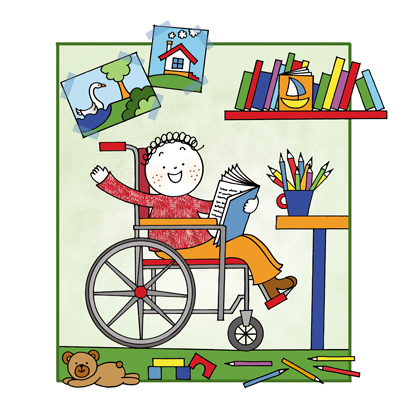
The storybook entitled Guardian Angel is about the everyday life of challenged children. The reason for writing this book and the amount of love included in this book was the same I had in the case of my previous books. I was guided by three major thoughts, which I wanted to pass on to everyone with this book: one of them is that everyone is good at something. The visually-impaired little girl in the story is for example always the best in playing blindfold-buff, because her hearing is a lot more sensitive compared to the visually non-impaired peers. The other major thought included that sometimes it is very useful putting ourselves in the situation of our fellow peers. In one of the fairytales some friends voluntarily decide on doing a school dance performance in wheelchairs in order to support their wheelchair-bound classmate. The third thought included love. Children, who are facing some kind of special difficulty/challenge, in most cases are not looking for pity or regret, but they are longing for love, acceptance, natural and identical treatment.
2. When was the first idea born in your mind to support children with your tales, who are living in non-everyday situations? Was a clearly capturable moment, which you can remember ever since?
During my over ten-year long storywriter career path I have experienced on many occasions that tales offer a great help to children in difficult situations. My first book, which was written with a specific supporting purpose, was published in 2010. I have received a request from the Gottsegen György National Institute of Cardiology to illustrate a story written for children suffering from heart diseases. The text was written by a volunteer of the clinic and an affected mother; I had to prepare the illustrations for the book. We have received excellent feedback, so we are currently working on the next book.
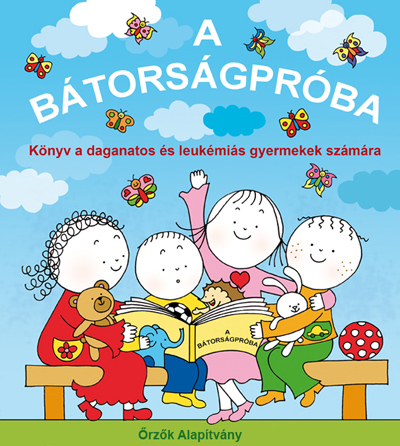
In 2011 I have received the next request from the Őrzők Alapítvány (Guardian Foundation) established by the paediatricians of the Tűzoltó Street Clinic to participate in a book written for children suffering from cancer and leukaemia. This book was the most beautiful and deepest work of my last years. I have learnt a lot from it, it was a challenge and serious task for me both in terms of humanly, mentally and illustration. The fundamental idea of the book came from an affected mother, who went down this route before with her child. Her maternal moral courage is exemplary; a fairy-tale like story tells the readers how we can give cheerful support to young children and shows how far can maternal love go. The reception of the book in general is very good, soon it will be published in a foreign language, and for me the biggest joy is if this book can provide families with support, who are going down on this extremely difficult route.
3. In the stories of the book entitled Guardian Angel you introduce the everyday life of challenged children and children with special needs. We can meet Samu, a boy in wheelchair; Lili, a blind girl; Misi, who is going through life with hearing-impairment and last, but not least Viola. Have you received any support in processing these topics? How did you go through the creative process and how could you gain experience from your children’s life and your surrounding environment?
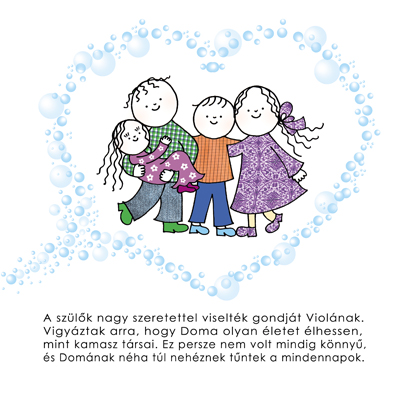
I have written and illustrated the book myself, I have drawn inspiration from communities whereby I regularly organise child entertainment programs. When I finished the manuscript I have sent it to eight therapists and I asked for their opinion. I have known these experts partly in person, because I previously held fairytale-screening in their institution (for example Pető Institute or SOFI, Institution for the Blind), and I chose some people as proofreaders because I read their books and works and I have learnt a lot from these works. The therapists read the manuscript, added their comments and gave me useful advice, which I gratefully took. By including their comments the book became a lot more complete and comprehensive. I have received partially professional advice, partially comments based on the several year long experience of the therapists. For example in the case of certain words they recommended a more fitting expression.
The book will be published by the Hungarian Maltese Charity Service, whose co-workers are befitting representatives of the topic of acceptance.
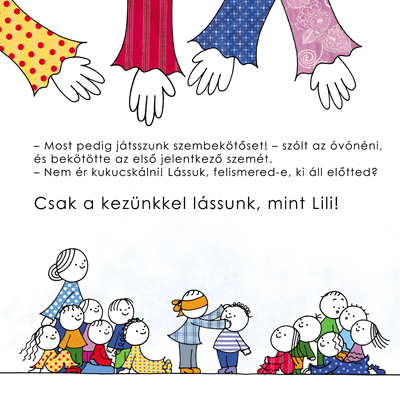
4.From these fairytales children (and also us adults) can collect information about acceptance; co-habitation and supporting each other . What is your opinion on integration, as an educational form?
I have been to numerous communities where children with special needs are brought up together with ordinary children. I think this method has a positive impact both ways, majority of the society can learn a lot in this situation. Children get used to easily and without any problems helping, supporting their challenged peers and they accept them with love, while challenged children find friends and support. The work of the therapists in such a group deserves all recognition.
5. I am sure that you are receiving many feedback and thank you letters in relation to your storybooks. Which one are you proud the most?
I am sincerely pleased to hear nice words; it is an uplifting feeling to realise that my tales bring joy to the lives of families. I highly appreciate all kind of letters; all letters represent motivation and invigorating power for me.
The main character of the latest Berry and Dolly book is a dumb a fairy, who is welcomed with lots of love and helped out by the characters. After the publication of this book I have received grateful letters from many families with children hard of hearing. It was great.
6. I have read on your website that you are regularly organising fairytale programs for children. Could you tell us a few words about it?

Besides children programs organised in libraries and at other public places since the beginning of my career I have been organising fairytale screening for closed communities, for children groups with special needs: in the kindergarten of autistic children, in the playhouse of the Down Association, for mentally challenged children and for young children who were born various development difficulties. Every meeting is a great experience for me, I get such emotional load from the little audience, which is hard to express. All this endless love, which I receive from the children, is all included in the Guardian Angel.
I design these fairytale programmes similarly to any other entertainment programs in libraries or at other places. There is no difference, I am telling the same stories also to these communities, maybe with a bit more care, more patiently and more attentively. Just like a gardener, who is looking after his/her tiny, sensitive flowers with a bit more care.
7. Finally let me ask you, what are you working on at the moment?
This is a very active period for me; I am working on several different books at the time. I am preparing a beautiful, big activity book for the Berry and Dolly series, with lots of activities and tasks; I loved doing the drawings for this activity book. There will also be ten new stories in the book, because the series is celebrating its tenth anniversary.
I am also working on an architectural book, which is targeting the older generations. I am using tint-drawing technique for the illustration of the book. Architecture is not only my original profession, but it represents also a significant support structure in my life, I am including architecture nearly in all my books in some way or form.
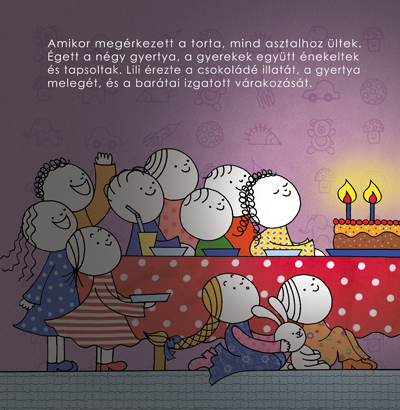
I am also planning to write a book for the youngest generation, which is related to music. I am a keen enthusiast of the legacy of Kodály and Bartók. Bartók is the true master of creating tension in music, he delayed not only certain sounds, but entire tunes; he was able to create unmatchable, sparkling musical dissonance followed by brilliant release. I love those sounds in the works of Kodály, which broke out with elemental power; as for his choral works I love the Angels and the Shepherds the most and the Evening Song. I also love his folk-based works too, for example the Marosszék Dances.





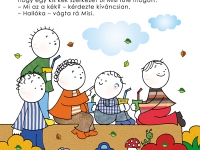


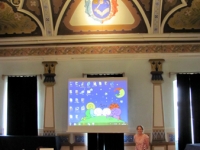


.jpg)